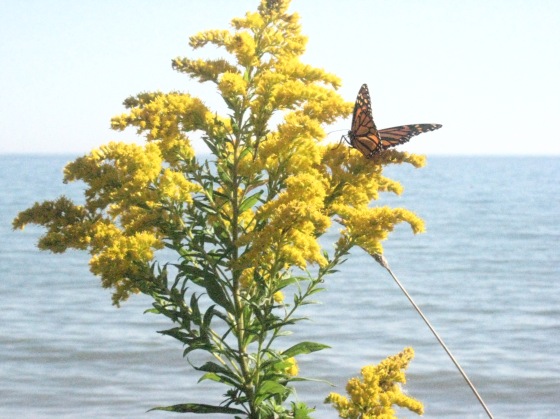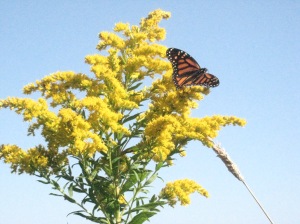It’s late August and Goldenrod is everywhere. I walked by Lake Ontario today, and was ecstatic to see several species of bees, three lady bugs, two wasps, one grasshopper, and one monarch butterfly luxuriating on the lush yellow florets of Goldenrod in full feathery bloom. Fascinated by the frantic activity of the bees and the majesty of the monarch in the hot afternoon sun, I stopped to observe.
The monarch grasped florets with its thin black legs, and occasionally opened and closed its orange wings as he or she gathered nourishment for the trip across the lake. I had just learned that a bulge in one of the black veins on the hind wings indicated male gender, but was so taken with the interaction between Goldenrod’s lunch menu and feasting visitors that I forgot to notice. I kicked myself for not having a camera.
The bees clung to florets, even hanging upside down as they gathered the riches. Some looked like bumble bees, some like yellow jackets. Others could almost be mistaken for flies. Sometimes they flew the short trip to a nearby ochre buffet proffered on the tip of another four-foot stem.
Maybe, I thought, just maybe, all these life forms would still be here if I beetled home, grabbed camera, and zoomed back. Luck was with me. Half an hour later, the multi-specied community was still harmoniously harvesting pollen and nectar. Click. Click.
I must admit I had never really appreciated Goldenrod until this moment. What did it do besides give me hay fever? Here by the lake I could clearly see it offered sustenance to winged wildlife.
This past weekend, I had another Goldenrod moment. I drove out to Campbell’s Honey House (on Campbell Road west of Warkworth, Ontario) to get my winter supply of unfiltered honey. I handed Mrs. Campbell my jars.
“Would you like summer honey or fall?” she asked.
“What’s the difference?”
“The bees make summer honey from summer flowers,” she said, “and right now the fall honey is mostly from Goldenrod, and that’s why it’s a deeper amber colour.”
Goldenrod! It offered sweet sustenance to human life, too. How could I have misjudged it all these years? Ignorance is not bliss.
To top it off, my doctor told me that it’s unlikely my, or anyone else’s, hay fever is caused by Goldenrod. Ragweed is the usual culprit. The two just happen to blossom at the same time.
Folks, this land of ours is alive! Let’s keep it that way.
~~~~~~~
Thanks to Kathryn McHolm for teaching me how to see gender in Monarch butterflies. Thanks to Leslie and Peter Campbell for teaching me about their bees’ honey. And thanks to fellow travelers, the bees, for the sweet winter ahead.
Written by Diane Taylor, author of The Gift of Memoir: Show Up, Open Up, Write


Glad you got the great pics
LikeLike
I think it’s time to upgrade my camera!
LikeLike
Ah… I love this post, Diane. Made me smile in wonder and appreciation. Thank you.
LikeLike
And you make me smile.
LikeLike
Our goldenrod is just coming into bloom now. I will go and watch for all this wildlife. Thank you.
LikeLike
Enjoy your trip into the Wild. 🙂
LikeLike
Goldenrod = pure, golden goodness. 🙂
LikeLike
Absolutely!
LikeLiked by 1 person
Beautiful photos. 🙂
LikeLike
Wish I had more like them. It’s an art, learning to walk/see with camera.
LikeLiked by 1 person
It sure is Diane. And I believe you’ve done a wonderful job. 🙂
LikeLike
So nice to be reminded of the beauties of goldenrod. It was a big part of our summers growing up, but I haven’t seen it in many years. Thank you!
LikeLike
Nostalgia for the landscapes of former times – I understand that well!
LikeLike
I almost jumped the goldenrod gun and said “What, that is not the culprit” but, alas, your connections are on the path so was glad to hear the nasty RAGWEED emerge.
Lynda
LikeLike
Poor old ragweed! “Must be good for something”, I thought as I reached for my herb book, and discovered medicinal uses for the roots, and tea from the leaves!
LikeLike
Beautiful, Dee. I was right there with ya, enjoying every golden moment!
LikeLike
Kathy, so nice to have your company!
LikeLike
You write with deep feeling and observation sparkling with good nature and hope.
LikeLike
Much appreciated, Chris.
LikeLike
Goldenrod and Monarch Butterflies. The thing of my Midwest childhood. You are making me homesick
LikeLike
I’m not sorry! 🙂 We live on an amazing planet. Most of it is ocean, where you now live and breathe and see new wondrous things (and make me a little jealous).
LikeLiked by 1 person
I love this wildflower which grows everywhere in Latvia, as well. Up to now, I just didn’t know its English name. Thanks to your poetic story, I will know it. I noticed it was added to bouquets here in Canada. We would just most often put it in a vase with some simple tree branches or other wildflowers or wild berry stems.
It was great the story came with a picture. Thanks!
LikeLike
How interesting the golden rod thrives in Latvia, too!
LikeLike
Diane, I love how you went home and got your camera. I can relate to this well. These are lovely, lovely pictures with an intriguing lesson too.
Blessings ~ Wendy
LikeLike
Thanks, Wendy. And you are a pro with your camera – a real enrichment to your posts.
LikeLiked by 1 person
Happy you got the considerable pics..
LikeLiked by 1 person
Thank you. You have a great website, with focus on Indian wildlife. Good luck!
LikeLike
Another lovely lesson from your wise observations. How wonderful to learn that rather than causing you an allergic reaction, the goldenrod was providing you sweet honey.
LikeLiked by 1 person